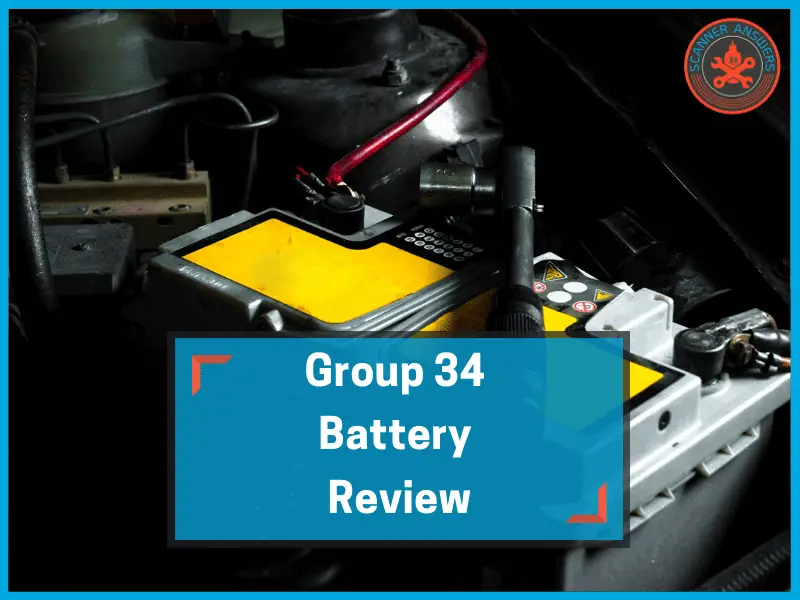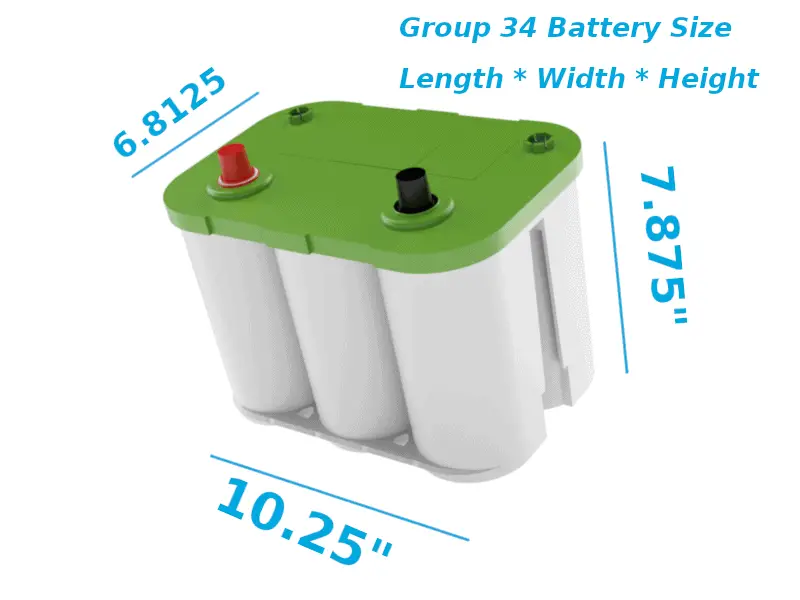Hey I’m Vince and today we’re tackling a Group 34 battery review and information guide. What does this strange naming scheme mean, and what sizes are these batteries? Read on to learn more!

As if choosing between gel cell, flooded, and AGM car batteries are not enough, there’s also the question of, what battery group size does my car/truck need? Yes, batteries also differ in size and are the reason why Honda vehicles have smaller batteries than your old Dodge Ram or Chevy Nova.
Skip the Group 34 Battery Review and see my two picks:
What does Group 34 battery mean?
If you found out your vehicle requires a group 34 battery, it means many things. For starters, it means the required battery size is medium-large, which means the battery is slightly bigger than medium but smaller than a large battery.
Generally speaking, group 34 batteries have a 20h capacity in the 50 to 75 Ah range. Most also provide 750-900 CCA (cold cranking amps) and around 100 to 145 minutes reserve capacity. When you crunch the numbers, these batteries are rather powerful than you might expect.
Read more about battery amps here
In terms of weight, they usually tip the scales between 37 and 51 pounds. Of course, weight is dependent on many factors including battery type and the internal construction of the unit.
What size is a group 34 battery?
The physical dimensions are 10.25 x 6.8125 x 7.875 inches. This translates roughly to 26 x 17 x 20 cm. In terms of actual size, group 34 batteries are smaller than group 27 but are larger than similar group 31.

Chart below found on BatteryEquivalents.com. Check out their site for more helpful battery-related resources!
| Battery Group Size | Length x Width x Height (inches) | Length x Width x Height (cm) |
| Group 24 | 10.25 x 6.812 x 8.875 | 26 x 17.3 x 22.5 |
| Group 27 | 12.0625 x 6.8125 x 8.875 | 30.6 x 17.3 x 22.5 |
| Group 31 | 13 x 6.8125 x 9.4375 | 33 x 17.3 x 24 |
| Group 34 | 10.25 x 6.8125 x 7.875 | 26 x 17.3 x 20 |
| Group 35 | 9.0625 x 6.875 x 8.875 | 23x 17.5 x 22.5 |
And with that in mind, remember this: a larger group size does NOT mean a physically larger battery, and the same principle holds true for car batteries with lower number groups.
What does the group size of a car battery mean?
Some time back, smart people at the BCI (Battery Council International) decided it would be a good idea to have a standard naming scheme for battery sizes. So they got together and settled on Group Name.
Vehicle manufacturers need to seriously consider the battery size when designing a new car, truck, or SUV. The Battery Group Size is created as an industry standard to accurately determine the physical size of the battery by measuring the Length x Width x Height.
Also, group sizing the battery also helps manufacturers in designing the electrical system of the vehicle. Why is this so? Battery group sizing also has something to do with the orientation or polarity of the positive and negative posts on the battery itself.
With this standard, it provides a simple guideline in automotive batteries, which comes especially handy when it’s time for a replacement. The simplest and easiest way to finding a replacement battery is to determine the group size. Instead of measuring your existing battery using a tape measure or ruler (you poor sod), you can search for the Group Size printed on the label of the old battery.
If you’re working with a used car and you can’t find the battery group size, check the owner’s manual. Knowing the group size is the easiest way to get a battery replacement, even if you don’t go straight to an auto care center or battery dealer.
What are the various battery group sizes?
In order to make it clear, it’s important to know the different battery group sizes. Not all cars are made the same, and some vehicles might have a different group size battery even from the same manufacturer.
There are three types of car batteries according to group size:
- Side-post batteries. As the name implies, side-post batteries have cable ends that screw on the side of the battery instead of having battery terminals on top of the unit. Side-post batteries are not rare. In fact, most vehicles manufactured by General Motors are equipped with this type of battery. Side-post car batteries are typically group 70, group 74, group 75, and group 78.
- Recessed top post batteries. More popularly known as an ‘international battery’ found in most European vehicle brands like Audi, BMW, Mercedes-Benz, and Volkswagen, this type of battery has top posts that are recessed in the corners. This means the posts are almost the same height as the battery casing. This design is perfect if the battery is located in the trunk or under the back seat. The group sizes of recessed top post batteries are typically group 41, group 42, group 47, group 48, and group 49.
- Standard top post batteries. For most import and some American-made vehicles, standard top post batteries are the preferred choice. This is the most common battery group size seen in modern vehicles. However, some group sizes have the same width and length but may have a lower height. It all boils down to vehicle design. In terms of group size, standard top post batteries are typically group 24, group24F, group 25, group 34, group 35, group 51, group 51R, group 52, group 58, group 58R, group 59, and group 65.
But don’t get confused. Some vehicles can handle a larger battery than what is stated in the owner’s manual. You need to remember that a larger battery will usually have more power and reserve capacity than a smaller unit.
This means it’s possible to fit a larger-size battery in your vehicle, and you should seriously consider doing so if your ride is peppered with aftermarket accessories like LED light bars, bigger amplifiers for banging audio systems, or a bevy of in-vehicle chargers for your many mobile devices.
However, there are limits to what the hood and the battery case can hold. If you use a larger battery that is taller than it is wider, you may end up with shorted circuits as the terminals may touch or make direct contact with the metal hood.
Best group 34 battery review
So you’ve determined that you need this size, but which one should you pick? Choosing the right kind means the difference between effortless starting or getting stranded in the middle of nowhere. Honestly you’ll probably find the lowest price if you have a Walmart or Costco nearby. These stores are usually cheaper to buy batteries online because they don’t have a ship a heavy 70lb battery to your door. However, if you live in a smaller town like I used to, you may have to purchase one online. If that’s the case, here’s two products that we’d suggest looking into with a quick Group 34 battery review:
Optima RedTop – Top of the Line Group 34 Battery
If you know anything about batteries then you’ve heard the legendary name: Optima
Sure these batteries are going to set you back a couple hundred (at the time of writing this) but what’s the price of the peace of mind that your car is going to start on a cold, -20F degree day when you gotta get to work?
The Optima Redtop is the perfect battery for most cars and trucks. It takes a beating, doesn’t leak, can be mounted in various positions, and comes with a three-year warranty.
ACDelco 34 AGM – a solid Group 34 battery for the money
Next up is the AC Delco. Now I included this one because it’s a lot cheaper than the Optima, but still made from a reputable brand.
Are AC Delco batteries any good?
Well, if you’re a true gear head needing the top of the line battery with the highest CCA around, then you should stick with the more expensive RedTop batteries. However, if you’re like most car owners who roll in their stock Honda, Toyota, Ford, Chevy commuting to work or the grocery store, then you should be just fine with this AC Delco.
This particular model still comes with a 3 year warranty, is sealed AGM, hold a good charge, and delivers the cranking power you’ll need to get your car started.
Read more about choosing a car battery.
Two general types of car batteries
Wet cell batteries
This is the flooded lead-acid battery developed specifically for automotive applications. There are two types of wet cell batteries: SLI battery (starting, lighting, and ignition) which is the battery in your vehicle, and deep cycle battery which are most commonly utilized in marine applications.
Additionally, wet cell batteries can be classified as maintenance and maintenance-free. In modern cars, SLI batteries have semi-solid electrolytes in a sealed case, which means the electrolytes never require replenishing over the life of the battery.
But if you have a conventional SLI wet cell battery with small fill holes on top, it means the electrolytes need topping up every now and then.
VRLA (valve-regulated lead-acid)
This is a sealed battery and does not require gasses to be vented out from the inner plates. And since a VRLA battery is sealed, it also means it can be installed in any orientation without fear of spillage or loss of power. But since the battery is totally sealed, it also means VRLA batteries are practically unserviceable.
There are two basic types of VRLA batteries:
- Gel Cell
- AGM (absorbed glass mat).
Which is better? Both are resistant to high temperatures, have virtually no risk of spillage, and are unaffected by excess shock or vibration.
If you take a cross-section of the plates inside an AGM battery, you’ll find the electrolyte held in place by glass mats instead of flooding the plates with electrolytes. The glass mats consist of thin fibers that are meshed together.
And while AGM batteries are more expensive than conventional flooded batteries, group 34 AGM batteries tend to have a higher CCA along with higher reserve capacity.
Read more about the different types of batteries
I’m rebuilding an old car and would like to use a different battery group size. What do I do?
The answer depends on many things like make and model of vehicle, electrical loads, location of the battery, etc. While we understand not all mechanics or car owners are engineers, it’s always best to talk to an expert when it comes to modified or specialized vehicles. It’s not simply upgrading from a group 34 to a group 31 battery. There are many factors that need to be considered before using a different battery group size.
Of course, you can do it the old-fashioned way by measuring the space available under the hood or in the trunk, but why take the risk? If you don’t know what you’re doing, then it’s probably time that someone else does it for you.
Conclusion
I hope this Group 34 Battery review and information guide has helped you understand more about batteries, sizes, CCA, and brands are right for you.
Knowing the Group Size is a fuss-free way to ask for a new battery replacement.
As always, before replacing your battery consult the owner’s manual or service manual of the vehicle.
-Vince

